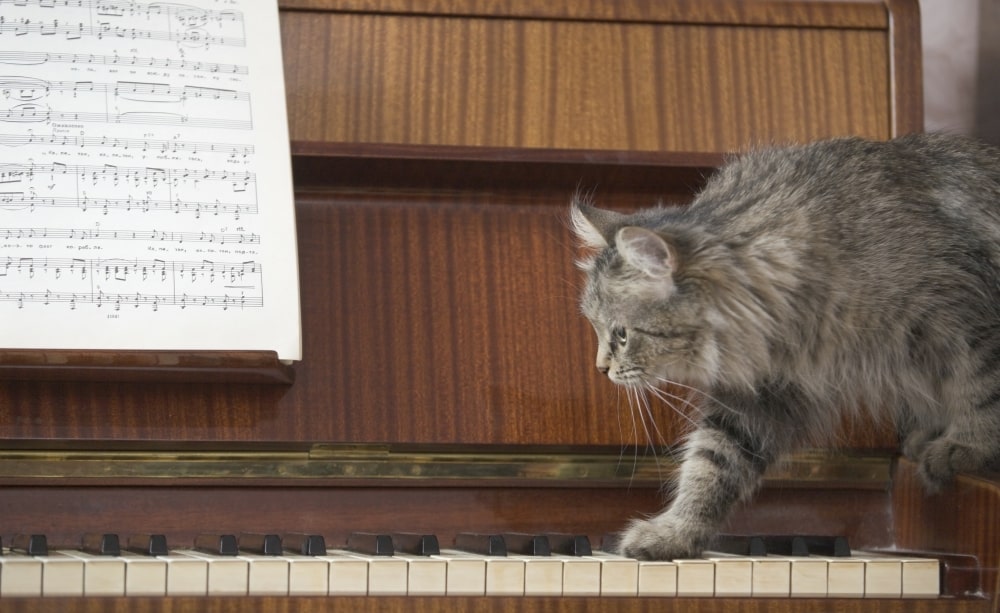When searching for new songs, singers will often look at the lowest and highest notes to see if they fall into a comfortable range.
The vocal range refers to the tonal distance of notes from the lowest to the highest. However, this measurement of a song can be somewhat deceptive, as the highest note may happen only once and very quickly at that.
Tessitura is another important factor to consider.
Here we will look at:
- what tessitura is
- how to find the tessitura of a song
- why it is important to understand tessitura
What is Tessitura?

Think of the difference between how high a ladder is (vocal range) versus which step(s) you will spend most of your time standing on (tessitura).
Tessitura (Italian for "texture) refers to where most of the vocal line or notes lie in a song.
For example, the chorus of Katy Perry's “Teenage Dream” has a vocal range of G4 to D5, which is just over a half-octave and is not extremely large. The highest note, D5, is at the top of the singer's transition (the area between the chest and head voice) and can be daunting for the singer. However, you only hit the note twice in each chorus. Therefore, if the sung note is not that strong, the listener may or may not pick up on it.
The chorus's vocal tessitura centers largely on Bb4; you will sing this note over twenty times on each chorus! If this note is not strong, the listener will definitely be made aware.
This Bb4 sits right in the middle of the vocal bridge or mix voice area and can be a trouble spot (where the voice is likely to crack). Its constant repetition where the voice transitions make this song a tough slog if the singer has not yet learned to balance this area or bridge location.
In fact, Bb4 can be prone to pulling up chest voice (using too much of the lower register coordination). Therefore, if this note is sung too heavy or with too much of the lower voice or chest register in it, the singer will quickly fatigue while singing these music phrases.
Isolated notes that are sung infrequently in a song outside of the comfortable range of the singer are less likely to cause a problem. Still, if these notes are consistently sung outside of the tessitura of their voice, the singer is likely to encounter problems such as recognizable register break and vocal fatigue. And if sung with poor technique for a long time, there is possible vocal damage down the road.
Here is another example of female voice tessitura;
Pop singers Mariah Carey and Whitney Houston had ease in singing and large vocal ranges at the peaks of their careers. But they would still choose songs where most of their notes would be in a certain tessitura. Mariah Carey would sing in her whistle register, but only for a moment in the song in these upper extremes, the rest of the time, she would be singing in a more common range for her distinctive voice quality.
Deep voices or bass range voices, such as Johnny Cash, would still use the same principle when choosing songs or writing songs for their voice profile.
Likewise, untrained singers or even intermediate voice types who may have a limited range would still sing in a certain tessitura. Still, they will choose songs in an ideal tessitura for their tone of voice types or natural range.
Voice Types

All singers have a particular sweet spot in their voice and an area in their lower vocal range where the notes take on a particularly pleasing quality. This could be high or low, depending on the singing voice types. The location of the sweet spot in the human voice will tend to differ depending on the singer's vocal type or vocal classification.
For example, with proper vocal training and diligent practice, a baritone with good singing techniques can often learn to sing a convincing high C. However, although they are hitting the correct note, they may be reaching pitch limits in their range of pitches, so the quality of this note will be different from a tenor. For example, tenor voices will likely have more brightness and brilliance in the sound, whereas the baritone might have a slightly darker sound in the upper register.
Also, the tenor will likely project a greater sense of ease in the note, and the listener will sense that the voice can go even higher and have more dramatic intensity. In contrast, the baritone's high C will likely be heavier, projecting a sense that the voice is reaching its upper limits.
The tenor has a general range better suited to these high notes and songs with a high tessitura.
In comparison, a tenor singing a G below the high C will not have the intensity of a baritone on the note. The baritone voice type will have a more thrilling quality as the note sits higher in the baritone's vocal range.
The tessitura of tenor music will sit higher than that of a baritone range or bass voices, even though they can sing many of the same pitches. The composer will aim to place the tessitura in the sweet spot of the voice.
Your Vocal Sweet Spot
Think of Bruno Mars vs. John Legend. They both compose songs and choose keys to have the tessitura sit where their voice sounds best. Generally, these songs sit in their comfortable singing range.
While contemporary singing and contemporary music do not have the same strict parameters around voice type as classical music, it is still important to know where your voice works best.
Since the average voice has a general range of over two octaves, you should strive to find keys that put songs in your vocal sweet spot.
One of the main reasons singers study vocal techniques and practice is to expand this sweet spot and give themselves a wider range of vocal tessitura choices. However, knowing your voice type is still helpful when choosing your vocal repertoire.
Determining Tessitura

Determining a song's tessitura can be a bit trickier than finding the overall vocal range as you need to examine the song closer. Again, basic music knowledge and understanding of vocal registers will be helpful for this.
This is why in a piece of sheet music, it's handy to identify the lowest notes to the highest notes on the music staff and have a basic knowledge of where vocal bridges occur in the musical piece. This way, you'll analyze music quickly to see where the voice pitch trouble spots are and if the tessitura is particularly difficult.
You want to find where most of the notes lie within a song. Some songs will have a more balanced, wider tessitura, with the notes being spread more evenly over the range. Other songs will be more focused within a small part of the range.
Find the basic tessitura of the verse, then the chorus, and the bridge (if there is one) by finding where the notes concentrate.
By seeing where the concentration of the notes lies in the music structure, you can make a more informed decision on song choice and what you need to work on. This process is the same for both the contemporary singer and the musical theatre singer.
Song Choice
Knowing the basic tessitura of songs can be helpful in choosing songs, either for performance, practicing, or for teachers assigning songs to their students.
One example is Adele's “Rolling In the Deep.” While this song goes to the C5 (and even the Eb5 for a brief moment) in the chorus, most of the song, and therefore the tessitura, sits below the singer's transition area.
While this can help the singer work on their lower notes or chest voice, it does little to help teach a singer how to mix or balance their voice in the register transition.
Adele's voice type is also lower than the average female's, making the C5 she sings on the word "all" very intense. A female with a higher singing voice may imitate Adele's thickness and intensity, causing her to over-muscle and constrict the pitch when trying to match this sound of dramatic intensity.
Knowing the difference between range and tessitura is an important tool for the singer and the voice teacher.
If you are looking to expand your general range to be able to sing a wide range of songs finding a qualified voice teacher is easier than ever with many online voice lessons available.
To learn more about my books, courses, and John's Singing School, please visit johnhenny.com. And if you are interested in online vocal lessons, you can reach out to our front desk at [email protected], and we would be happy to answer your questions.
P.S. If you want to develop your belt voice and grow your vocal range and power, check out my Boldly Belting course.